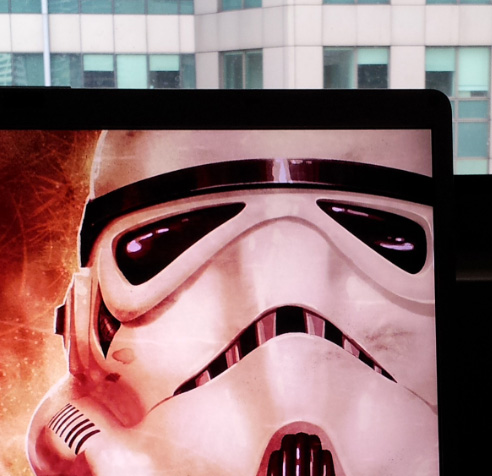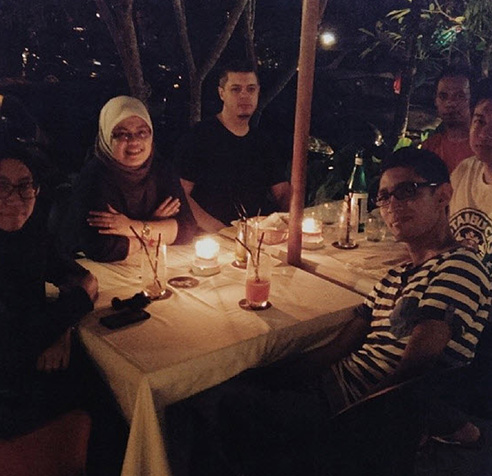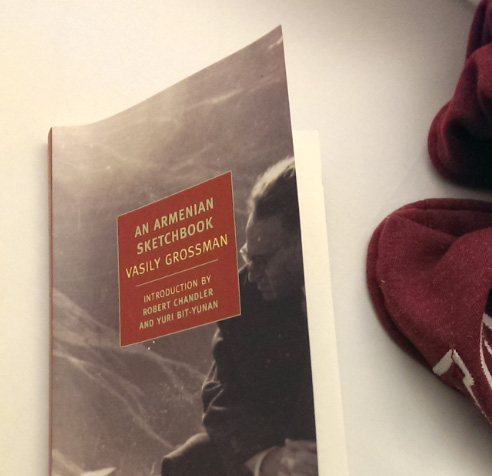Welcome to the first instalment of A Day In The Life Of series, where we shall feature every team member in Stampede about how we go through typical work day. While similar series may have been going around in other blogs, A Day In The Life Of series in Stampede is different – we all work remotely, our clients span across about multiple time zones hence managing their expectations while working remotely and signing-in at different times.

Ultimately this series will discuss not only habits and workflow, but also personal principles ingrained in our working life which has helped us create great work year after year.
To kick off the series, I interviewed Shaza Hakim, Partner and Creative Lead for Stampede Design. I am, as always, amazed by her energy and extraordinary work ethics.

Hi Shaza, first of all, thanks for agreeing to be the first to be interviewed for this A Day In The Life series. Could you tell us about yourself and how did you first get into the Web?

Dude, you’re being really formal! My name is Shaza Hakim and I am the Partner and Creative Lead for Stampede Design, the company that I have founded with my partner Dov Nazarov since 2006. I graduated from University Teknologi Petronas in 2004 with a degree in Information Technology and a minor in Corporate Management.
Back then, my original plan was to absorb as much experience and climb the career ladder in multinational corporations. That was “The Dream”. Things took a turn when I realised that the rigid structure of these companies do not quite work for me, so I went and uproot myself from the big city and moved to Langkawi to work as project manager in a smaller company.
A lot of the things about web industry I knew now, I learned while on the job with Dov. The industry was still small and flourishing during that time. Sharing and discussing knowledge among each other was easier and less ferocious unlike now (laughs).
One day I woke up with this strong urge to learn and practice design. So I fired up Photoshop and went through tutorials after tutorials, spending about 4-5 hours a day to learn the principles of design in general, then moving onward with web design and development after work hours.
When Dov and I first established Stampede, we were pretty excited to get featured on a few CSS galleries. Soon enough, we began to receive inquiries from people all over the world, asking if we could take on small web design projects for them. Thrilled by these requests, we quit our day jobs in good faith and decided to focus on Stampede full time. We never looked back ever since.
I think it also helps that both Dov and I are autodidacts — we learned a lot all by ourselves and by observation. My heroes back in the day and until now are folks such as Jeffrey Zeldman, Jason Santa Maria and Cameron Moll. I still look up to them.

Because this is A Day In The Life series, tell us about your typical day on a working day – from waking up to going to bed?

I run a company and I also design at the same time. So while I try to keep to a routine, once in a while I vary my work hours so I would always be available for client on multiple timezones and I would also have some time for myself.
What never changes is that I indulge in long breakfast, whatever time this might be. I’d usually wake up at 10 am, spend about two hours at the dining table devoting myself to my breakfast, my home-brewed coffee and a book — away from the interventions of any digital devices.

I enjoy reading many authors and genres and my interests vary from Gabriel Garcia Marquez to science fiction to history to economics. Right now, I’m powering through the entire Discworld collection by Terry Pratchett. I keep my reading exclusively non-work-related during these hours.
I would normally sign in to work at noon and the first hour would be spent on replying client emails. During the next hour I would figure out if the team members need anything from me — design, answers, assignments etc. so I would try to complete them before they sign in.
I try not to read anything work-related outside of work hours, so after doing a number of web reading in this first portion of the day I would also collect and curate them in Joota* and share them on Basecamp for the team or Facebook.

We have our daily meetings at 5pm to recap on project updates – what was done, what is pending and what we need to accomplish our daily goals. We call this 5-Minute Meeting or in short, 5MM. It works the same way as a daily scrum meeting in other companies – it helps set the context for the day’s work while keeping the discussion brisk but relevant. These activities build my momentum towards designing.
Running a business means I don’t have the luxury to set a time to start designing — the team and the clients come first. I usually spend 3-4 hours a day on design. When I am in the zone, the hours could be way longer but never more than eight hours. My focus would be terribly diminished by then.
Also, meetings are necessary but they could be draining. I would usually reserve them towards the end of the day when most of my tasks are taken care of. Before signing off, I would make sure to have some ‘watercooler session’ with the team where we would tease each other, share links, just chat – stuff we do to cool off after a long day at work. Fun times.**

So much for not having a routine, you say! I heard about your dual monitors and how it improves your productivity. Tell us more about it.

Those monitors, my friend, are lifesavers. I would divide my schedule into two — the Manager and the Maker. One monitor is devoted to the Manager section and the apps used to run a company: Basecamp, invoicing, Skype, emails.

Another monitor is for the Maker schedule – solely for Photoshop. I still design in Photoshop but I increasingly like to tweak things right on the browser. This segregation is really important because if I were to design in laptop, I found that switching between windows is breaking my flow.
I try to capture ideas and try them out there and then so I appreciate the speed and focus of having only one output channel when designing. You can read more about the Manager vs Maker schedule here.

So Shaza, everyone in Stampede works remotely. This is a brave feat for a business owner to allow this, where managers could not monitor their employees there and then. How did you first decide on this, what are the challenges on running a remote working team and of course, what are the fun parts?

We love Langkawi and we find it difficult to move out of this pretty island. However, resource pull in Langkawi is really small — everyone who have decided to work for web would mostly have moved out to bigger cities. It is also unrealistic to hire and ask people to relocate to Langkawi.
So we decided to find a solution that works best for us and our people – hence, remote working. I guess remote working appeals much for people whose core work does not revolve much human interactions. Back in 2005, we posted a vacancy on Lowyat.net and it was a hit for the forum goers because the demographics were those who were tech-savvy and more comfortable with the idea of working from anywhere.
While hiring, we also did test runs with people we feel good about. Can they deliver on time? Are they reliable? I must say that hiring remotely is one of Stampede’s strength. It is fascinating because of the very idea that you can work from anywhere you want! Also I must add, the talent pool is larger because your choice is not limited to a particular city or country you are hiring.
One of the greatest challenges however is to build trust among your team. This can be done from the start by hiring the right people — those with Stampede material, as we often say. These people are willing to learn and unlearn what they have known from their previous jobs, have the ability to motivate themselves and always happy to be a part of the team despite not being physically together. They will also be able to perform with minimal supervision, someone who can always pick themselves up.
But then again, if your employee needs constant supervision, something is wrong because self-discipline is something everyone should have anyway.

Now for the fun part. I could say everything but mostly because there is less distractions. It is self-explanatory but when you can do things with not much distraction, you are often even more productive. I can also work anywhere. When you work remotely, you will find that your work doesn’t dictate your life. We love to think that Stampede has given our people this freedom.
Second fun part – meeting the team face-to-face once in a while! It is like a mini reunion where we often tease each other mercilessly like a family we are. The inside jokes are even more magnified when we see each other in person. The get-togethers we organise often leave us with warm fuzzy feelings towards people we work with long after we return to our respective cities.

You run a company while also design for clients at the same time. At this intersection between business and design, could you tell us what have you learned while trying to balance and satisfy needs from both areas?

(This she says without hesitation) The team comes first. Always.
Business: We all know that a business has to be profitable – however, if by making tons of money you are squeezing the happiness out of your team, it is not worth it. There were some instances where clients were being less than respectful to our people so we decided that it wasn’t going to work out.
For some, this might not be a profitable business decision, but what sustains our company is the people. Other meaningful projects always follow later when we prioritise our people. This is something Dov and I have established from the start — what type of company we want to be. Instead of money-centric, we decided to be more on meaning-centric.
While being a hands-on business owner as well as a designer, I also learned to empathise with the struggle of learning while working. If I were just a business owner or manager, I don’t think we would be able to have a close-knit team just like we do now. Businesses should help each other more.
For instance, in the intersection of design, there are some design solutions that might profit just you but not the client. My advice? Don’t go that route. Find other ways which benefit both of you – let’s go back to the brief, find out who the target users are, identify the point where business and user goals can complement each other. Because I am a business owner as well, I understand that all businesses want to create value. So be that kind of company who also help your fellow businessperson to create value.
Design: I learned that whatever I created reflects my company. So I will make a point to create something that gives meaning to someone in return. I love being able to wake up to this job every day, and I’m grateful for that. Again, it goes back to the type of company we decided to become.

You read a lot as well. I know this is hard to answer – tell us some of your favourite books.

You are right, this is definitely the hardest question. I don’t have any preferences actually. I mentioned that I’m powering through the entire Discworld series. I could usually finish a book in two days, a week maybe if it requires focus and reflection.

That could probably place me as a hippie among other business owners who read sales and motivational books, but that does not matter. I am also totally head over heels with Gabriel Garcia Marquez‘s works. Others might find his big paragraphs too intense but I think he couldn’t hold back the intensity. There is so much he tried to capture, it was almost as if he worried words would escape him.
There are the few books and genre that shaped my childhood — I was a big fan of Greek mythology, historical books, anything by Jules Verne. I have this habit I share with my siblings – we would all scour for Detective Conan comics during meal time, it’s almost Pavlovian. As for design-related books, I am a fan of Paul Arden’s, Stephen Sagmeister’s and Bill Moggridge’s writings. I draw a lot of inspiration from passages in books.
I am also one of the people who is known to buy one book in many different covers — that is just a designer’s curse. I also tend to buy books in every city I visited, like the last time I bought a Turkish copy of Dan Brown’s Inferno in Istanbul and The Hunchback of Notre Dame across the very same cathedral in in Paris.

Any advice you would like to disperse to people wishing to be in web and development industry — particularly new entrepreneurs?

I would like to send separate advice to these two groups – designers/developers and another to business owners. As a designer, you are allowed to make mistakes to learn but as a business owner, a mistake could cost you and your team.
For designers and developers: Do not be discouraged by the level of skills and knowledge the experienced folks in the industry have, because half of us are just winging it. Don’t worry to make mistakes. Make mistakes faster, acknowledge the mistake and move on.
Be generous and share your knowledge. People who have substance are more interested in other people. There is no need to call yourself a ninja or rockstar — respect the process, it is going to be evident by your body of work. Also be careful what you put out there, it will decide what sort of people you are going to attract. If you decide to put up good, meaningful stuff that will make a difference no matter how little, you are going to attract good people and vice versa.
For business owners: If you want to be interesting to a customer, be interested in the customer first. Make their goal yours. Unfortunately as easy as it is, not many businesses do this. We are still learning as well.
Don’t be afraid to take small steps. Very early on, you have to decide what kind of business you want to be – your moral compass, what kind of people you want to hire, what sort of company you want to become. Try to have goals like “I want to create things that will change people’s life” not the “I want to have one million dollar in my company account in three years” because if you do achieve that goal, then what?
Another thing I might mention is that — in the early years, try to be self-sustainable. If possible, try to take no outside funding at all. However if you still need it, make sure you need to be able to justify to three of your closest peers that you feel are your great confidants personally and professionally. Three is the ideal number — not too little, not too many.
Be nice to your employee. Everybody is an employee once, so you would not want to be treated like that when you were an employee before. Good people attract more good people, it’s just that easy.
A very simple word of advice to both groups: Don’t be precious with your knowledge. You probably have inspired so many people with the work you have created, so spend time to chat and share your experience generously. You get so much more in return.

As the interview concluded, I was left exhausted from so much positivity. Next in the series: Shaiful Borhan.
* We are part of the design and development team who produced Joota!
** Things Stampede Team Says is a collection of impressive things we blurted out every day at work.
(photo by Shaza Hakim and Zana Fauzi)
